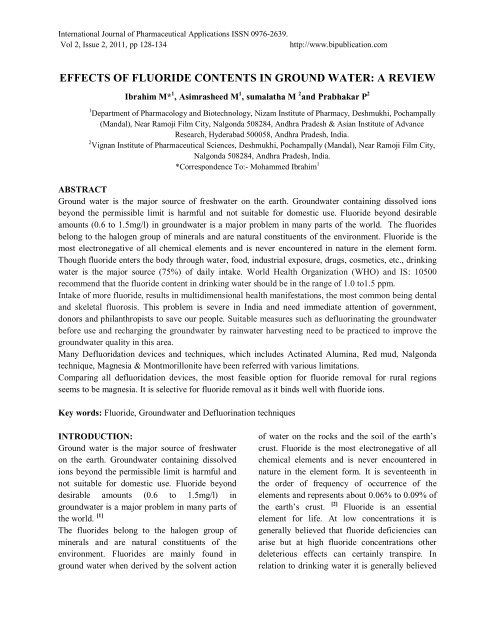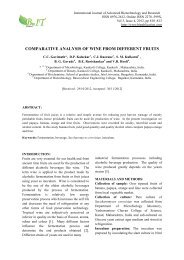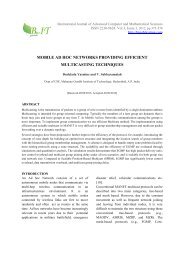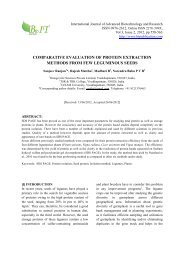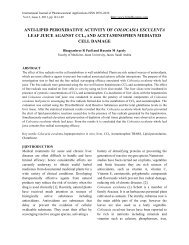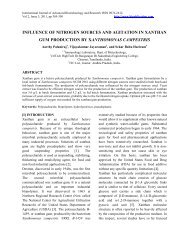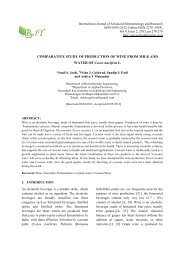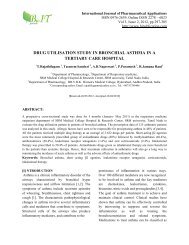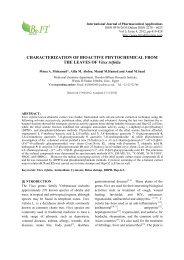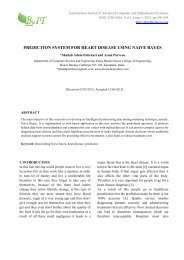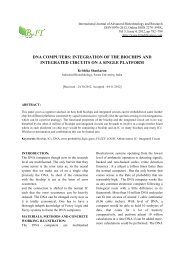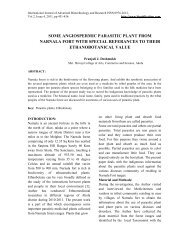effects of fluoride contents in ground water - BioIT international ...
effects of fluoride contents in ground water - BioIT international ...
effects of fluoride contents in ground water - BioIT international ...
You also want an ePaper? Increase the reach of your titles
YUMPU automatically turns print PDFs into web optimized ePapers that Google loves.
International Journal <strong>of</strong> Pharmaceutical Applications ISSN 0976-2639.<br />
Vol 2, Issue 2, 2011, pp 128-134<br />
http://www.bipublication.com<br />
EFFECTS OF FLUORIDE CONTENTS IN GROUND WATER: A REVIEW<br />
Ibrahim M* 1 , Asimrasheed M 1 , sumalatha M 2 and Prabhakar P 2<br />
1 Department <strong>of</strong> Pharmacology and Biotechnology, Nizam Institute <strong>of</strong> Pharmacy, Deshmukhi, Pochampally<br />
(Mandal), Near Ramoji Film City, Nalgonda 508284, Andhra Pradesh & Asian Institute <strong>of</strong> Advance<br />
Research, Hyderabad 500058, Andhra Pradesh, India.<br />
2 Vignan Institute <strong>of</strong> Pharmaceutical Sciences, Deshmukhi, Pochampally (Mandal), Near Ramoji Film City,<br />
Nalgonda 508284, Andhra Pradesh, India.<br />
*Correspondence To:- Mohammed Ibrahim 1<br />
ABSTRACT<br />
Ground <strong>water</strong> is the major source <strong>of</strong> fresh<strong>water</strong> on the earth. Ground<strong>water</strong> conta<strong>in</strong><strong>in</strong>g dissolved ions<br />
beyond the permissible limit is harmful and not suitable for domestic use. Fluoride beyond desirable<br />
amounts (0.6 to 1.5mg/l) <strong>in</strong> <strong>ground</strong><strong>water</strong> is a major problem <strong>in</strong> many parts <strong>of</strong> the world. The <strong>fluoride</strong>s<br />
belong to the halogen group <strong>of</strong> m<strong>in</strong>erals and are natural constituents <strong>of</strong> the environment. Fluoride is the<br />
most electronegative <strong>of</strong> all chemical elements and is never encountered <strong>in</strong> nature <strong>in</strong> the element form.<br />
Though <strong>fluoride</strong> enters the body through <strong>water</strong>, food, <strong>in</strong>dustrial exposure, drugs, cosmetics, etc., dr<strong>in</strong>k<strong>in</strong>g<br />
<strong>water</strong> is the major source (75%) <strong>of</strong> daily <strong>in</strong>take. World Health Organization (WHO) and IS: 10500<br />
recommend that the <strong>fluoride</strong> content <strong>in</strong> dr<strong>in</strong>k<strong>in</strong>g <strong>water</strong> should be <strong>in</strong> the range <strong>of</strong> 1.0 to1.5 ppm.<br />
Intake <strong>of</strong> more <strong>fluoride</strong>, results <strong>in</strong> multidimensional health manifestations, the most common be<strong>in</strong>g dental<br />
and skeletal fluorosis. This problem is severe <strong>in</strong> India and need immediate attention <strong>of</strong> government,<br />
donors and philanthropists to save our people. Suitable measures such as defluor<strong>in</strong>at<strong>in</strong>g the <strong>ground</strong><strong>water</strong><br />
before use and recharg<strong>in</strong>g the <strong>ground</strong><strong>water</strong> by ra<strong>in</strong><strong>water</strong> harvest<strong>in</strong>g need to be practiced to improve the<br />
<strong>ground</strong><strong>water</strong> quality <strong>in</strong> this area.<br />
Many Defluoridation devices and techniques, which <strong>in</strong>cludes Act<strong>in</strong>ated Alum<strong>in</strong>a, Red mud, Nalgonda<br />
technique, Magnesia & Montmorillonite have been referred with various limitations.<br />
Compar<strong>in</strong>g all defluoridation devices, the most feasible option for <strong>fluoride</strong> removal for rural regions<br />
seems to be magnesia. It is selective for <strong>fluoride</strong> removal as it b<strong>in</strong>ds well with <strong>fluoride</strong> ions.<br />
Key words: Fluoride, Ground<strong>water</strong> and Defluor<strong>in</strong>ation techniques<br />
INTRODUCTION:<br />
Ground <strong>water</strong> is the major source <strong>of</strong> fresh<strong>water</strong><br />
on the earth. Ground<strong>water</strong> conta<strong>in</strong><strong>in</strong>g dissolved<br />
ions beyond the permissible limit is harmful and<br />
not suitable for domestic use. Fluoride beyond<br />
desirable amounts (0.6 to 1.5mg/l) <strong>in</strong><br />
<strong>ground</strong><strong>water</strong> is a major problem <strong>in</strong> many parts <strong>of</strong><br />
the world. [1]<br />
The <strong>fluoride</strong>s belong to the halogen group <strong>of</strong><br />
m<strong>in</strong>erals and are natural constituents <strong>of</strong> the<br />
environment. Fluorides are ma<strong>in</strong>ly found <strong>in</strong><br />
<strong>ground</strong> <strong>water</strong> when derived by the solvent action<br />
<strong>of</strong> <strong>water</strong> on the rocks and the soil <strong>of</strong> the earth’s<br />
crust. Fluoride is the most electronegative <strong>of</strong> all<br />
chemical elements and is never encountered <strong>in</strong><br />
nature <strong>in</strong> the element form. It is seventeenth <strong>in</strong><br />
the order <strong>of</strong> frequency <strong>of</strong> occurrence <strong>of</strong> the<br />
elements and represents about 0.06% to 0.09% <strong>of</strong><br />
the earth’s crust. [2] Fluoride is an essential<br />
element for life. At low concentrations it is<br />
generally believed that <strong>fluoride</strong> deficiencies can<br />
arise but at high <strong>fluoride</strong> concentrations other<br />
deleterious <strong>effects</strong> can certa<strong>in</strong>ly transpire. In<br />
relation to dr<strong>in</strong>k<strong>in</strong>g <strong>water</strong> it is generally believed
EFFECTS OF FLUORIDE CONTENTS IN GROUND WATER: A REVIEW<br />
that too little (1.5mg/l)<br />
[3, 4]<br />
can affect bone and teeth structure.<br />
Among the <strong>water</strong> quality parameters, <strong>fluoride</strong> ion<br />
exhibits unique properties as its concentration <strong>in</strong><br />
optimum dose <strong>in</strong> dr<strong>in</strong>k<strong>in</strong>g <strong>water</strong> is advantageous<br />
to health and if the concentration exceeds the<br />
limit, this affects the health. [5] High <strong>fluoride</strong><br />
concentration <strong>in</strong> the <strong>ground</strong> <strong>water</strong> and surface<br />
<strong>water</strong> <strong>in</strong> many parts <strong>of</strong> the world is a cause <strong>of</strong><br />
great concern. The ma<strong>in</strong> source <strong>of</strong> <strong>fluoride</strong> <strong>in</strong><br />
<strong>ground</strong> <strong>water</strong> is <strong>fluoride</strong>-bear<strong>in</strong>g rocks such as<br />
fluorspar, fluorite, cryolite, fluorapatite and<br />
hydroxylapatite. [6] Also the content <strong>in</strong> <strong>ground</strong><br />
<strong>water</strong> is a function <strong>of</strong> many factors such as<br />
availability and solubility <strong>of</strong> <strong>fluoride</strong> m<strong>in</strong>erals,<br />
velocity <strong>of</strong> flow<strong>in</strong>g <strong>water</strong>, pH, temperature,<br />
concentrations <strong>of</strong> calcium and bicarbonate ions <strong>in</strong><br />
[7, 8]<br />
<strong>water</strong>.<br />
Though <strong>fluoride</strong> enters the body through <strong>water</strong>,<br />
food, <strong>in</strong>dustrial exposure, drugs, cosmetics, etc.,<br />
dr<strong>in</strong>k<strong>in</strong>g <strong>water</strong> is the major source (75%) <strong>of</strong> daily<br />
<strong>in</strong>take. [9] Due to its strong electronegativity,<br />
<strong>fluoride</strong> is attracted to positively charged calcium<br />
<strong>in</strong> teeth and bones. Major health problems caused<br />
by <strong>fluoride</strong> are dental fluorosis, teeth mottl<strong>in</strong>g,<br />
skeletal fluorosis and deformation <strong>of</strong> bones <strong>in</strong><br />
children as well as adults. [10] Excess <strong>fluoride</strong><br />
affects plants and animals also.<br />
Health Impacts <strong>of</strong> Fluoride:<br />
Fluoride is well recognized as an element <strong>of</strong><br />
public health concern. Fluoride is present<br />
universally <strong>in</strong> almost every <strong>water</strong> (higher<br />
concentrations are found <strong>in</strong> <strong>ground</strong><strong>water</strong>), earth<br />
crust, many m<strong>in</strong>erals, rocks etc. It is also present<br />
<strong>in</strong> most <strong>of</strong> everyday needs, viz. toothpastes,<br />
drugs, cosmetics, chew<strong>in</strong>g gums, mouthwashes<br />
and so on. [11, 12] Though a small amount <strong>of</strong> it is<br />
beneficial for human health for prevent<strong>in</strong>g dental<br />
carries, it is very harmful when present <strong>in</strong> excess<br />
<strong>of</strong> 1.0 ppm. World Health Organization (WHO)<br />
and IS: 10500 recommend that the <strong>fluoride</strong><br />
content <strong>in</strong> dr<strong>in</strong>k<strong>in</strong>g <strong>water</strong> should be <strong>in</strong> the range<br />
<strong>of</strong> 1.0 to1.5 ppm.<br />
Intake <strong>of</strong> more <strong>fluoride</strong>, results <strong>in</strong><br />
multidimensional health manifestations, the most<br />
[13, 14]<br />
common be<strong>in</strong>g dental and skeletal fluorosis.<br />
Higher concentration <strong>of</strong> <strong>fluoride</strong> also causes<br />
respiratory failure, fall <strong>of</strong> blood pressure and<br />
general paralysis. Loss <strong>of</strong> weight, anorexia,<br />
anemia, wast<strong>in</strong>g and cochexia are among the<br />
common f<strong>in</strong>d<strong>in</strong>gs <strong>in</strong> chronic <strong>fluoride</strong> poison<strong>in</strong>g.<br />
Cont<strong>in</strong>uous <strong>in</strong>gestion <strong>of</strong> nonfatal dose <strong>of</strong><br />
<strong>fluoride</strong>s causes permanent <strong>in</strong>hibition <strong>of</strong> growth.<br />
Fluoride ions <strong>in</strong>hibit a variety <strong>of</strong> enzymes <strong>of</strong>ten<br />
by form<strong>in</strong>g complexes with magnesium ions and<br />
other metal ions. [15-17]<br />
In India, there has been an <strong>in</strong>crease <strong>in</strong> <strong>in</strong>cidence<br />
<strong>of</strong> dental and skeletal fluorosis with about 62<br />
million people at risk [18] due to high <strong>fluoride</strong><br />
concentration <strong>in</strong> dr<strong>in</strong>k<strong>in</strong>g <strong>water</strong>. Dental fluorosis<br />
is endemic <strong>in</strong> 14 states and 150,000 villages <strong>in</strong><br />
India with the problem most pronounced <strong>in</strong> the<br />
states <strong>of</strong> Andhra Pradesh, Bihar, Gujarat, Madhya<br />
Pradesh, Punjab, Rajasthan, Tamil Nadu and<br />
Uttar Pradesh. [19]<br />
Prevalence <strong>of</strong> Fluorosis:<br />
India is among the 23 nations where<strong>in</strong> a large<br />
population suffers from dental and skeletal<br />
Fluorosis due to high F– concentration <strong>in</strong><br />
<strong>ground</strong><strong>water</strong>. [20-22] India has acute public-health<br />
problems <strong>in</strong>duced by utilization <strong>of</strong> <strong>ground</strong><strong>water</strong><br />
as a source <strong>of</strong> dr<strong>in</strong>k<strong>in</strong>g <strong>water</strong>. The health<br />
problems aris<strong>in</strong>g as a result <strong>of</strong> <strong>fluoride</strong> (F)<br />
contam<strong>in</strong>ation are far more widespread <strong>in</strong> India.<br />
Fluorosis was first detected <strong>in</strong> India, among cattle<br />
and humans <strong>in</strong> Andhra Pradesh. [23] In India,<br />
approximately 60–65 million people dr<strong>in</strong>k<br />
<strong>fluoride</strong> contam<strong>in</strong>ated <strong>ground</strong><strong>water</strong>, and the<br />
number affected by fluorosis is estimated at 2.5–6<br />
million, predom<strong>in</strong>ately children. [24, 25] In India,<br />
the excessive presence <strong>of</strong> <strong>fluoride</strong>s <strong>in</strong><br />
<strong>ground</strong><strong>water</strong> is present <strong>in</strong> nearly 177 districts<br />
cover<strong>in</strong>g 19 states. It appears that high-well<br />
<strong>fluoride</strong> may exist <strong>in</strong> many more districts. [26] The<br />
prom<strong>in</strong>ent states, which are severely affected, are<br />
Andhra Pradesh, Rajasthan, Gujarat, Uttar<br />
Ibrahim M, et al. 129
EFFECTS OF FLUORIDE CONTENTS IN GROUND WATER: A REVIEW<br />
Pradesh, and Tamilnadu. [27, 28] Earlier reports <strong>in</strong><br />
different parts <strong>of</strong> India <strong>in</strong>dicate certa<strong>in</strong> <strong>in</strong>stances<br />
<strong>of</strong> fluorosis. [29] It is cited that dental fluorosis<br />
levels <strong>of</strong> 43% has been reported <strong>in</strong> Anantapur<br />
District <strong>of</strong> Andhra Pradesh. [30]<br />
Effect <strong>of</strong> Water Fluoride on human.<br />
Dental and skeletal fluorosis.<br />
Fluoride is among the substances for which there<br />
are both lower (0.6 mg/l) and upper (1.2 mg/l)<br />
limits <strong>of</strong> concentration <strong>in</strong> dr<strong>in</strong>k<strong>in</strong>g <strong>water</strong>, with<br />
identified health effect and benefits for human<br />
be<strong>in</strong>gs. [31] Very low doses <strong>of</strong> <strong>fluoride</strong> (1.5 mg/l), it leads to<br />
dental fluorosis or mottled enamel and<br />
excessively high concentration (>3.0 mg/l) <strong>of</strong><br />
<strong>fluoride</strong> may lead to skeletal fluorosis. In general,<br />
<strong>fluoride</strong> content <strong>in</strong> <strong>water</strong> between 1.5 and 2.0<br />
mg/l may lead to dental mottl<strong>in</strong>g, which is<br />
characterized <strong>in</strong>itially by opaque white patches<br />
on the teeth and <strong>in</strong> advanced stages leads to<br />
dental fluorosis (teeth display brown to black<br />
sta<strong>in</strong><strong>in</strong>g) followed by pitt<strong>in</strong>g <strong>of</strong> teeth surfaces.<br />
High manifestations <strong>of</strong> dental fluorosis are<br />
mostly found <strong>in</strong> children up to the age <strong>of</strong> 12<br />
years, and skeletal fluorosis [32] may occur when<br />
<strong>fluoride</strong> concentrations <strong>in</strong> dr<strong>in</strong>k<strong>in</strong>g <strong>water</strong> exceed<br />
4–8 mg/l. The high <strong>fluoride</strong> concentration<br />
manifests as an <strong>in</strong>crease <strong>in</strong> bone density lead<strong>in</strong>g<br />
to thickness <strong>of</strong> long bones and calcification <strong>of</strong><br />
ligaments. The symptoms <strong>in</strong>clude mild<br />
rheumatic/arthritic pa<strong>in</strong> <strong>in</strong> the jo<strong>in</strong>ts and muscles<br />
to severe pa<strong>in</strong> <strong>in</strong> the cervical sp<strong>in</strong>e region along<br />
with stiffness and rigidity <strong>of</strong> the jo<strong>in</strong>ts. The<br />
disease may be present <strong>in</strong> an <strong>in</strong>dividual at<br />
subcl<strong>in</strong>ical, chronic or acute levels <strong>of</strong><br />
manifestation. [33] Crippl<strong>in</strong>g skeletal fluorosis can<br />
occur when the <strong>water</strong> supply conta<strong>in</strong>s more than<br />
10 mg/l <strong>of</strong> <strong>fluoride</strong>. [34, 35] The severity <strong>of</strong><br />
fluorosis depends on the concentration <strong>of</strong> <strong>fluoride</strong><br />
<strong>in</strong> the dr<strong>in</strong>k<strong>in</strong>g <strong>water</strong>, daily <strong>in</strong>take, cont<strong>in</strong>uity and<br />
duration <strong>of</strong> exposure, and climatic conditions.<br />
Neurotoxicity and Neurobehavioral Effects<br />
Animal and human studies <strong>of</strong> <strong>fluoride</strong> have been<br />
published report<strong>in</strong>g adverse cognitive and<br />
behavioral <strong>effects</strong>. A few epidemiologic studies<br />
<strong>of</strong> Ch<strong>in</strong>ese populations have reported IQ deficits<br />
<strong>in</strong> children exposed to <strong>fluoride</strong> at 2.5 to 4 mg/L <strong>in</strong><br />
dr<strong>in</strong>k<strong>in</strong>g <strong>water</strong>.<br />
A few animal studies have reported alterations <strong>in</strong><br />
the behavior <strong>of</strong> rodents after treatment with<br />
<strong>fluoride</strong>, but the committee did not f<strong>in</strong>d the<br />
changes to be substantial <strong>in</strong> magnitude. More<br />
compell<strong>in</strong>g were studies on molecular, cellular,<br />
and anatomical changes <strong>in</strong> the nervous system<br />
found after <strong>fluoride</strong> exposure, suggest<strong>in</strong>g that<br />
functional changes could occur. These changes<br />
might be subtle or seen only under certa<strong>in</strong><br />
physiological or environmental conditions. More<br />
research is needed to clarify the effect <strong>of</strong> <strong>fluoride</strong><br />
on bra<strong>in</strong> chemistry and function.<br />
Endocr<strong>in</strong>e Effects<br />
The chief endocr<strong>in</strong>e <strong>effects</strong> <strong>of</strong> <strong>fluoride</strong> exposures<br />
<strong>in</strong> experimental animals and <strong>in</strong> humans <strong>in</strong>clude<br />
decreased thyroid function, <strong>in</strong>creased calciton<strong>in</strong><br />
activity, <strong>in</strong>creased parathyroid hormone activity,<br />
secondary hyperparathyroidism, impaired glucose<br />
tolerance, and possible <strong>effects</strong> on tim<strong>in</strong>g <strong>of</strong><br />
sexual maturity. Some <strong>of</strong> these <strong>effects</strong> are<br />
associated with <strong>fluoride</strong> <strong>in</strong>take that is achievable<br />
at <strong>fluoride</strong> concentrations <strong>in</strong> dr<strong>in</strong>k<strong>in</strong>g <strong>water</strong> <strong>of</strong> 4<br />
mg/L or less, especially for young children or for<br />
<strong>in</strong>dividuals with high <strong>water</strong> <strong>in</strong>take. Many <strong>of</strong> the<br />
<strong>effects</strong> could be considered subcl<strong>in</strong>ical <strong>effects</strong>,<br />
mean<strong>in</strong>g that they are not adverse health <strong>effects</strong>.<br />
However, recent work on borderl<strong>in</strong>e hormonal<br />
imbalances and endocr<strong>in</strong>e-disrupt<strong>in</strong>g chemicals<br />
<strong>in</strong>dicated that adverse health <strong>effects</strong>, or <strong>in</strong>creased<br />
risks for develop<strong>in</strong>g adverse <strong>effects</strong>, might be<br />
associated with seem<strong>in</strong>gly mild imbalances or<br />
perturbations <strong>in</strong> hormone concentrations. Further<br />
research is needed to explore these possibilities.<br />
Effects on Other Organ Systems<br />
The committee also considered <strong>effects</strong> on the<br />
gastro<strong>in</strong>test<strong>in</strong>al system, kidneys, liver, and<br />
Ibrahim M, et al. 130
EFFECTS OF FLUORIDE CONTENTS IN GROUND WATER: A REVIEW<br />
immune system. There were no human studies on<br />
dr<strong>in</strong>k<strong>in</strong>g <strong>water</strong> conta<strong>in</strong><strong>in</strong>g <strong>fluoride</strong> at 4 mg/L <strong>in</strong><br />
which gastro<strong>in</strong>test<strong>in</strong>al, renal, hepatic, or immune<br />
<strong>effects</strong> were carefully documented. Case reports<br />
and <strong>in</strong> vitro and animal studies <strong>in</strong>dicated that<br />
exposure to <strong>fluoride</strong> at concentrations greater<br />
than 4 mg/L can be irritat<strong>in</strong>g to the<br />
gastro<strong>in</strong>test<strong>in</strong>al system, affect renal tissues and<br />
function, and alter hepatic and immunologic<br />
parameters. Such <strong>effects</strong> are unlikely to be a risk<br />
for the average <strong>in</strong>dividual exposed to <strong>fluoride</strong> at 4<br />
mg/L <strong>in</strong> dr<strong>in</strong>k<strong>in</strong>g <strong>water</strong>. However, a potentially<br />
susceptible subpopulation comprises <strong>in</strong>dividuals<br />
with renal impairments who reta<strong>in</strong> more <strong>fluoride</strong><br />
than healthy people do.<br />
Genotoxicity and Carc<strong>in</strong>ogenicity<br />
Many assays have been performed to assess the<br />
genotoxicity <strong>of</strong> <strong>fluoride</strong>. S<strong>in</strong>ce the 1993 NRC<br />
review, the most significant additions to the<br />
database are <strong>in</strong> vivo assays <strong>in</strong> human populations<br />
and, to a lesser extent, <strong>in</strong> vitro assays with human<br />
cell l<strong>in</strong>es and <strong>in</strong> vivo experiments with rodents.<br />
The results <strong>of</strong> the <strong>in</strong> vivo human studies are<br />
mixed. The results <strong>of</strong> <strong>in</strong> vitro tests are also<br />
conflict<strong>in</strong>g and do not contribute significantly to<br />
the <strong>in</strong>terpretation <strong>of</strong> the exist<strong>in</strong>g database.<br />
Evidence on the cytogenetic <strong>effects</strong> <strong>of</strong> <strong>fluoride</strong> at<br />
environmental concentrations is contradictory.<br />
Whether <strong>fluoride</strong> might be associated with bone<br />
cancer has been a subject <strong>of</strong> debate. Bone is the<br />
most plausible site for cancer associated with<br />
<strong>fluoride</strong> because <strong>of</strong> its deposition <strong>in</strong>to bone and<br />
its mitogenic <strong>effects</strong> on bone cells <strong>in</strong> culture. In a<br />
1990 cancer bioassay, the overall <strong>in</strong>cidence <strong>of</strong><br />
osteosarcoma <strong>in</strong> male rats exposed to different<br />
amounts <strong>of</strong> <strong>fluoride</strong> <strong>in</strong> dr<strong>in</strong>k<strong>in</strong>g <strong>water</strong> showed a<br />
positive dose-response trend. In a 1992 study, no<br />
<strong>in</strong>crease <strong>in</strong> osteosarcoma was reported <strong>in</strong> male<br />
rats, but most <strong>of</strong> the committee judged the study<br />
to have <strong>in</strong>sufficient power to counter the evidence<br />
for the trend found <strong>in</strong> the 1990 bioassay.<br />
Several epidemiologic <strong>in</strong>vestigations <strong>of</strong> the<br />
relation between <strong>fluoride</strong> and cancer have been<br />
performed s<strong>in</strong>ce the 1993 evaluation, <strong>in</strong>clud<strong>in</strong>g<br />
both <strong>in</strong>dividual-based and ecologic studies.<br />
Several studies had significant methodological<br />
limitations that made it difficult to draw<br />
conclusions. Overall, the results are mixed, with<br />
some studies report<strong>in</strong>g a positive association and<br />
others no association.<br />
On the basis <strong>of</strong> the committee’s collective<br />
consideration <strong>of</strong> data from humans, genotoxicity<br />
assays, and studies <strong>of</strong> mechanisms <strong>of</strong> action <strong>in</strong><br />
cell systems (e.g., bone cells <strong>in</strong> vitro), the<br />
evidence on the potential <strong>of</strong> <strong>fluoride</strong> to <strong>in</strong>itiate or<br />
promote cancers, particularly <strong>of</strong> the bone, is<br />
tentative and mixed. Assess<strong>in</strong>g whether <strong>fluoride</strong><br />
constitutes a risk factor for osteosarcoma is<br />
complicated by the rarity <strong>of</strong> the disease and the<br />
difficulty <strong>of</strong> characteriz<strong>in</strong>g biologic dose because<br />
<strong>of</strong> the ubiquity <strong>of</strong> population exposure to <strong>fluoride</strong><br />
and the difficulty <strong>of</strong> acquir<strong>in</strong>g bone samples <strong>in</strong><br />
nonaffected <strong>in</strong>dividuals.<br />
A relatively large hospital-based case-control<br />
study <strong>of</strong> osteosarcoma and <strong>fluoride</strong> exposure is<br />
under way at the Harvard School <strong>of</strong> Dental<br />
Medic<strong>in</strong>e and is expected to be published <strong>in</strong><br />
2006. That study will be an important addition to<br />
the <strong>fluoride</strong> database, because it will have<br />
exposure <strong>in</strong>formation on residence histories,<br />
<strong>water</strong> consumption, and assays <strong>of</strong> bone and<br />
toenails. The results <strong>of</strong> that study should help to<br />
identify what future research will be most useful<br />
<strong>in</strong> elucidat<strong>in</strong>g <strong>fluoride</strong>’s carc<strong>in</strong>ogenic potential.<br />
Sorption<br />
A sorption process is normally designed <strong>in</strong> a plug<br />
flow filter column, <strong>in</strong>clud<strong>in</strong>g a medium that has a<br />
certa<strong>in</strong> capacity <strong>of</strong> absorption, adsorption or ion<br />
exchange <strong>of</strong> the <strong>fluoride</strong>. This process requires<br />
recharge or regeneration <strong>of</strong> the medium upon<br />
saturation. Numerous media are known to have<br />
defluoridation properties.<br />
However, due to capacity, availability and<br />
subsequent <strong>water</strong> quality limitations only bone<br />
char and activated alum<strong>in</strong>a are worth mention<strong>in</strong>g.<br />
The plants are based on bone char sorption,<br />
Ibrahim M, et al. 131
EFFECTS OF FLUORIDE CONTENTS IN GROUND WATER: A REVIEW<br />
which is the process <strong>of</strong> choice if acceptable by<br />
the community. Alternatively, similar set-ups can<br />
be utilized <strong>in</strong> the activated alum<strong>in</strong>a process. This<br />
is <strong>of</strong>ten preferred e.g. <strong>in</strong> strictly vegetarian<br />
societies that consider the use <strong>of</strong> (cow) bone char<br />
as unethical.<br />
Nalgonda [36] has developed its own method <strong>of</strong><br />
defluoridation which is cheap effective<br />
alternative depend<strong>in</strong>g upon the benefits to cost<br />
ratio. It’s easy for <strong>in</strong>stallation <strong>in</strong> rural area to<br />
avoid flourosis disease to certa<strong>in</strong> extent however<br />
it needs to be revised.<br />
A co-precipitation process is <strong>of</strong>ten carried out <strong>in</strong><br />
batch conta<strong>in</strong>ers, where the precipitat<strong>in</strong>g<br />
chemicals are totally mixed with the raw <strong>water</strong>.<br />
This process requires fill<strong>in</strong>g <strong>of</strong> <strong>water</strong> and<br />
chemicals, mix<strong>in</strong>g and settl<strong>in</strong>g and subsequent<br />
withdrawal <strong>of</strong> the treated <strong>water</strong> and the produced<br />
sludge. In the so-called Nalgonda technique high<br />
dosage <strong>of</strong> alum and lime are used <strong>in</strong> a<br />
coagulation/sedimentation process, where the<br />
precipitation <strong>of</strong> alum<strong>in</strong>ium hydroxide <strong>in</strong>stantly<br />
b<strong>in</strong>ds a part <strong>of</strong> the <strong>water</strong> <strong>fluoride</strong>.<br />
Nalgonda process design limitations.<br />
The Nalgonda process design is complicated and<br />
must be confirmed empirically. This is ma<strong>in</strong>ly<br />
because <strong>of</strong> the co-precipitation that lacks<br />
stoichiometry, the great variation <strong>in</strong> media quality<br />
and solubility and the efficiency be<strong>in</strong>g dependent<br />
on the raw <strong>water</strong> quality, <strong>in</strong> particular the <strong>fluoride</strong><br />
concentration, pH and the alkal<strong>in</strong>ity. Add<strong>in</strong>g<br />
alum as done <strong>in</strong> Nalgonda technique may not be<br />
ideal because alum<strong>in</strong>um is be<strong>in</strong>g <strong>in</strong>crim<strong>in</strong>ated <strong>in</strong><br />
the causation <strong>of</strong> Alzheimer’s disease <strong>in</strong> the west.<br />
Discussion and Conclusion:<br />
Ground<strong>water</strong> conta<strong>in</strong><strong>in</strong>g dissolved ions beyond<br />
the permissible limit is harmful and not suitable<br />
for domestic use. Fluoride concentration <strong>in</strong><br />
<strong>ground</strong><strong>water</strong> varies with the <strong>ground</strong><strong>water</strong> level<br />
fluctuation. Two dist<strong>in</strong>ct types <strong>of</strong> relationship<br />
between the <strong>ground</strong><strong>water</strong> level and <strong>fluoride</strong><br />
concentration were observed. In wells where the<br />
<strong>water</strong> table occurs at shallow depths, which are<br />
from 0 to 4.5 m below <strong>ground</strong> level, the <strong>fluoride</strong><br />
concentration was high when the <strong>water</strong> level was<br />
low and the <strong>fluoride</strong> concentration decreases with<br />
the rise <strong>in</strong> <strong>water</strong> table. Relative high <strong>fluoride</strong><br />
concentration dur<strong>in</strong>g the lower<strong>in</strong>g <strong>of</strong> <strong>water</strong> table<br />
is because <strong>of</strong> possible direct evaporation <strong>of</strong><br />
<strong>ground</strong><strong>water</strong> from the wells. The <strong>fluoride</strong><br />
concentration was low when the <strong>water</strong> level rises<br />
due to dilution by fresh ra<strong>in</strong><strong>water</strong> recharge.<br />
Weather<strong>in</strong>g <strong>of</strong> rocks and leach<strong>in</strong>g <strong>of</strong> <strong>fluoride</strong><br />
bear<strong>in</strong>g m<strong>in</strong>erals are the major reasons which<br />
contribute to elevated concentration <strong>of</strong> <strong>fluoride</strong> <strong>in</strong><br />
<strong>ground</strong><strong>water</strong>. The other important natural<br />
phenomenon that contributes to high <strong>fluoride</strong> is<br />
evaporation. Thus, the granitic rocks <strong>of</strong> Nalgonda<br />
possess the highest <strong>fluoride</strong> content than <strong>in</strong> any<br />
other parts <strong>of</strong> the world. Hence, the major reason<br />
for elevated <strong>ground</strong><strong>water</strong> <strong>fluoride</strong> concentration<br />
<strong>in</strong> this area must be due to weather<strong>in</strong>g <strong>of</strong> rocks<br />
and rock–<strong>water</strong> <strong>in</strong>teraction.<br />
Fluorosis is dreaded disease caused by<br />
consumption <strong>of</strong> excess <strong>fluoride</strong>. This is caused<br />
chiefly through consumption <strong>of</strong> <strong>water</strong> hav<strong>in</strong>g<br />
excess <strong>fluoride</strong> content. The WHO standards<br />
prescribe 1.5 PPM as maximum level <strong>of</strong> <strong>fluoride</strong><br />
<strong>in</strong> dr<strong>in</strong>k<strong>in</strong>g <strong>water</strong>. However deep bore wells do<br />
carry excess <strong>fluoride</strong> caus<strong>in</strong>g various bone and<br />
physical deformities.<br />
This problem is severe <strong>in</strong> India and need<br />
immediate attention <strong>of</strong> government, donors and<br />
philanthropists to save our people. Suitable<br />
measures such as defluor<strong>in</strong>at<strong>in</strong>g the <strong>ground</strong><strong>water</strong><br />
before use and recharg<strong>in</strong>g the <strong>ground</strong><strong>water</strong> by<br />
ra<strong>in</strong><strong>water</strong> harvest<strong>in</strong>g need to be practiced to<br />
improve the <strong>ground</strong><strong>water</strong> quality <strong>in</strong> this area.<br />
Many Defluoridation devices and techniques,<br />
which <strong>in</strong>cludes Act<strong>in</strong>ated Alum<strong>in</strong>a, Red mud,<br />
Nalgonda technique, Magnesia &<br />
Montmorillonite have been referred with various<br />
limitations.<br />
Compar<strong>in</strong>g all defluoridation devices, the most<br />
feasible option for <strong>fluoride</strong> removal for rural<br />
regions seems to be magnesia. It is selective for<br />
Ibrahim M, et al. 132
EFFECTS OF FLUORIDE CONTENTS IN GROUND WATER: A REVIEW<br />
<strong>fluoride</strong> removal as it b<strong>in</strong>ds well with <strong>fluoride</strong><br />
ions.<br />
REFERENCES<br />
1. K. Br<strong>in</strong>dha. R. Rajesh. R. Murugan. L.<br />
Elango (2010). Fluoride contam<strong>in</strong>ation <strong>in</strong><br />
<strong>ground</strong><strong>water</strong> <strong>in</strong> parts <strong>of</strong> Nalgonda District,<br />
Andhra Pradesh, India. Environ Monit<br />
Assess, DOI 10.1007/s 10661–010–1348-0.<br />
2. Wedepohl, K.H.: Hand book <strong>of</strong><br />
geochemistry. Spr<strong>in</strong>gerverlage berl<strong>in</strong>. (Ed.:<br />
Heidelberf). New York. 2, 9 K-1 pp. (1974).<br />
3. Edmunds, W.M. and P.L. Smedley: Fluoride<br />
<strong>in</strong> natural <strong>water</strong>s occurrence, controls and<br />
health aspects. In: Medical geology. New<br />
York (Ed.: O.Selenus). Academic Press<br />
(2003).<br />
4. Edmunds, W.M. and P.L.Smedley: Ground<br />
<strong>water</strong> geochemistry and health: An overview.<br />
In: Environmental geochemistry and health<br />
(Eds: J.D. Appleton, R. Fuge, G.J.H. Mc<br />
call). Special Publication 113. London:<br />
Geological Soceity. Pp. 91-105 (1996).<br />
5. Venkata Moham, S., Nikhila, P. and Reddy,<br />
S.J., Determ<strong>in</strong>ation <strong>of</strong> <strong>fluoride</strong> content <strong>in</strong><br />
dr<strong>in</strong>k<strong>in</strong>g <strong>water</strong> and development <strong>of</strong> a model<br />
<strong>in</strong> relation to some <strong>water</strong> quality parameters,<br />
Fresenius Envir Bull, 4, 297-302 (1995).<br />
6. Meenakshi, V.K., Garg.Karik., Renuka and<br />
Anju Malik, Ground <strong>water</strong> quality <strong>in</strong> some<br />
villages <strong>in</strong> Haryana, India: Focus on <strong>fluoride</strong><br />
and fluorosis, Jounal Hazardous Material,<br />
106B, 85-97(2004).<br />
7. Agarwal, V., Vaish, A.K. and Vaish, P,<br />
Ground <strong>water</strong> quality: Focus on <strong>fluoride</strong> and<br />
fluorosis <strong>in</strong> Rajasthan, Curr. Sci, 739, 743-<br />
746 (1977).<br />
8. Chandra, S.J., Thergaonkar, V.P. and<br />
Sharma, R., Water quality and dental<br />
fluorosis, Ind. J. Pub, H115(25), 47-51(1981)<br />
9. Sarala, K. and Rao P.R., Endemic fluorosis<br />
<strong>in</strong> the village Ralla Anantapuram <strong>in</strong> Andhra<br />
Pradesh – An epidemiological study,<br />
Fluoride, 26, 177-180 (1993).<br />
10. Susheela, A.K., Kumar, A., Betnagar, M. and<br />
Bahadur, M., Prevalence <strong>of</strong> endemic fluorosis<br />
with gastro-<strong>in</strong>test<strong>in</strong>al manifestations <strong>in</strong><br />
people liv<strong>in</strong>g <strong>in</strong> some north-Indian villages,<br />
Fluoride, 26, 97-104 (1993).<br />
11. Thatte, C.D. Match<strong>in</strong>g <strong>of</strong> <strong>water</strong> supply with<br />
grow<strong>in</strong>g demands. J. IWWA. 1994; 26(2): pp<br />
67-71.<br />
12. Subba Rao, N., Prakasa Rao, J. Niranjan<br />
Babu, P. Chandra Rao P. and Krishna<br />
Rao, G. Hydrogeochemical zon<strong>in</strong>g <strong>in</strong><br />
crystall<strong>in</strong>e terra<strong>in</strong> and its significance to<br />
<strong>water</strong> quality. Jour.Geol. Soc. India, Vol. 49,<br />
No. 6, 1997: pp 715-719.<br />
13. Hubner, M.; Geochemische <strong>in</strong>terpretation<br />
non fluorid/hydroxide Austauscheversuchen<br />
and Tonm<strong>in</strong>eralen. Ber Dentsch. Geo. Geol.<br />
Wise. B.M<strong>in</strong>er. LagerstattenForsch,1969:pp<br />
1415.<br />
14. Ramamohana Rao, N. V. and Rajyalakshmi,<br />
K. Studies <strong>of</strong> <strong>water</strong> quality and <strong>in</strong>cidence <strong>of</strong><br />
fluorosis <strong>in</strong> Andhra Pradesh. Proceed<strong>in</strong>gs <strong>of</strong><br />
the Symposium on Fluorosis, Hyderabad.<br />
1974: pp 477-486.<br />
15. Andezhath, S. K., Susheela, A. K., & Ghosh,<br />
G. (1999). Fluorosis management <strong>in</strong> India:<br />
The impact due to network<strong>in</strong>g between health<br />
and rural dr<strong>in</strong>k<strong>in</strong>g <strong>water</strong> supply agencies,<br />
AHS-AISH Publication, 260, 159-165.<br />
16. Pillai, K. S., & Stanley, V. A. (2002).<br />
Implications <strong>of</strong> <strong>fluoride</strong>-an endless<br />
uncerta<strong>in</strong>ty. Journal <strong>of</strong> Environmental<br />
Biology, 23, 81-87.<br />
17. Ramesam, V. and Rajagopalan, K. Fluoride<br />
<strong>in</strong>gestion <strong>in</strong>to the natural <strong>water</strong> <strong>of</strong> hard rock<br />
areas, Pen<strong>in</strong>sular India. Jour. Geol. Soc.<br />
India. Vol. 26, 1985: pp 125-132.<br />
18. Rao, R. J. and Naidu, M. G. C.<br />
Geochemistry <strong>of</strong> high <strong>fluoride</strong> natural <strong>water</strong>s<br />
if Jaggaiahpalem, fluorosisendemic village<br />
near Visakhapatnam district, Andhra<br />
Ibrahim M, et al. 133
EFFECTS OF FLUORIDE CONTENTS IN GROUND WATER: A REVIEW<br />
Pradesh, Inst. Symposium on Recent<br />
researches and applications <strong>of</strong> Geochemistry,<br />
Patna, India.1973: pp 6.<br />
19. Subba Rao, N. Factors affect<strong>in</strong>g optimum<br />
development <strong>of</strong> <strong>ground</strong><strong>water</strong>s <strong>in</strong> crystall<strong>in</strong>e<br />
terra<strong>in</strong> <strong>of</strong> the Eastern Ghats, Visakhapatnam<br />
area, Andhra Pradesh, India, Jour. Geol.<br />
Soc.India. Vol. 40, No. 5, 1992: pp 462467.<br />
20. UNICEF, State <strong>of</strong> the art report on the extent<br />
<strong>of</strong> <strong>fluoride</strong> <strong>in</strong> dr<strong>in</strong>k<strong>in</strong>g<strong>water</strong> and the result<strong>in</strong>g<br />
endemicity <strong>in</strong> India. Fluorosis Research and<br />
Rural Development Foundation for UNICEF,<br />
NewDelhi, 1999.<br />
21. WHO, Fluoride <strong>in</strong> dr<strong>in</strong>k<strong>in</strong>g <strong>water</strong>, World<br />
Health Organization, Geneva, 2006.<br />
22. Pillai, K. S. and Stanley, V. A., Implication<br />
<strong>of</strong> <strong>fluoride</strong> – an endless uncerta<strong>in</strong>ty. J.<br />
Environ. Biol., 2002, 23, 81–87<br />
23. Short, H. E.,Mc Robert. R., Bernard, T.<br />
W.,&Mannad<strong>in</strong>ayar, A. S. (1937). Endemic<br />
fluorosis <strong>in</strong> the Madras, Presidency. Indian<br />
Journal <strong>of</strong> Medical Research, 25,553–561.<br />
24. Athavale, R. N., & Das, R. K. (1999).<br />
Beware! Fluorosis is zero<strong>in</strong>g <strong>in</strong> on you.<br />
Down to Earth, 8, 24–25.<br />
25. Subba Rao, N. (2008). Fluoride <strong>in</strong><br />
<strong>ground</strong><strong>water</strong>, Varaha river bas<strong>in</strong>,<br />
Vsakhapatnam district, Aandhra Pradesh,<br />
India. Environmental Monitor<strong>in</strong>g<br />
Assessment, 152,47–60.<br />
26. Susheela, A. K. (2001). A treatise on f<br />
luorosis (p. 15). Delhi: Fluorosis Research<br />
and Rural Development Foundation.<br />
27. Muralidharan, D., Nair, A. P., &<br />
Sathyanarayana, U.(2002). Fluoride <strong>in</strong><br />
shallow aquifers <strong>in</strong> Rajgarh tehsil <strong>of</strong> Churu<br />
district Rajasthan—An arid<br />
environment.Current Science, 83, 699–702<br />
28. Subba Rao, N. (2008). Fluoride <strong>in</strong><br />
<strong>ground</strong><strong>water</strong>, Varaha river bas<strong>in</strong>,<br />
Vsakhapatnam district, Aandhra Pradesh,<br />
India. Environmental Monitor<strong>in</strong>g<br />
Assessment, 152,47–60.<br />
29. Reddy, N. B., & Prasad, K. S. S. (2003).<br />
Pyroclastic <strong>fluoride</strong> <strong>in</strong> <strong>ground</strong><strong>water</strong>s <strong>in</strong> some<br />
parts <strong>of</strong> Tadipatri Taluk, Anantapur District,<br />
Andhra Pradesh. Indian Journal <strong>of</strong><br />
Environmental Health, 45, 285–288.<br />
30. ISI, Dr<strong>in</strong>k<strong>in</strong>g <strong>water</strong> standards, Table 1.<br />
Substance and characteristics affect<strong>in</strong>g the<br />
acceptability <strong>of</strong> <strong>water</strong> for domestic use<br />
18,10500. Indian Standard Institution, New<br />
Delhi, 1983.<br />
31. Apambire, W. B., Boyle, D. R. and Michel,<br />
F. A., Geochemistry, genesis and health<br />
implications <strong>of</strong> floriferous <strong>ground</strong> <strong>water</strong>s <strong>in</strong><br />
the upper regions <strong>of</strong> Ghana. Environ. Geol.,<br />
1997, 33, 13–24.<br />
32. Teotia, S. P. S. and Teotia, M., Endemic<br />
skeletal fluorosis: cl<strong>in</strong>ical and radiological<br />
variants. Fluoride, 1988, 21, 39–44.<br />
33. World Health Organization, Fluorides and<br />
human health. World Health Organization<br />
Publ., Monogr. Ser. 59, 1970, WHO, Geneva.<br />
34. Boyle, D. R. and Chagnon, M., An <strong>in</strong>cidence<br />
<strong>of</strong> skeletal fluorosis associated with<br />
<strong>ground</strong><strong>water</strong>s <strong>of</strong> the Maritime Carboniferous<br />
Bas<strong>in</strong>, Gaspe Region, Quebec. Can. Environ.<br />
Geochem. Health, 1995, 17, 5–12.<br />
35. Reddy, N. B., & Prasad, K. S. S. (2003).<br />
Overview on defluoridation Andhra Pradesh.<br />
Indian Journal <strong>of</strong> Environmental Health, 45,<br />
285–288.<br />
36. www.nalgonda.com<br />
Ibrahim M, et al. 134


